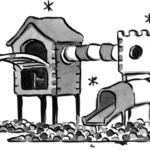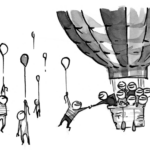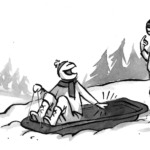Present browsers are very forgiving; they quietly appropriate or gloss over
many widespread HTML errors. This makes it simple for folks to expertise the
pleasure of making their very own net pages with a minimal of frustration – if
a web page shows accurately, then it’s “proper.”
Article Continues Under
Sadly, by hiding the necessity for construction that the net would require
because it strikes in the direction of XHTML and XML, these forgiving browsers have helped
create a world of structural HTML illiterates. So long as
browsers proceed to parse and show HTML that isn’t well-formed or
legitimate, we are going to by no means study the best methods, and we are going to by no means get to a
structural net.
Instructing the following era to the following era#section2
I used to be lately invited to be a visitor speaker for the graphic design and
desktop publishing courses at Santa Teresa Excessive Faculty in San José, California. It’s a pleasure to show of their fantastic laptop lab, which has two rooms with thirty iMacs in every room. Over the course of 4 days, I train
the fundamentals of HTML; on the primary and third days I current materials, and the
college students get to observe on the second and fourth days. For sure,
shoehorning any helpful quantity of fabric about HTML right into a fifty-minute
class interval is a problem, but it surely’s nice enjoyable. A few of the college students in
the category could have already finished some work with HTML, so I can deputize
them to help different college students.
This 12 months, I made a decision to get forward of the curve and train
XHTML – that’s, HTML that conforms to the principles of XML – and
thereby hangs a story.
The mechanics of XHTML#section3
On Tuesday, the primary day I taught, I advised the category what HTML means (one
scholar advised me he’d heard that it stands for “How
To Make Love,” and
was terribly disenchanted once I advised him in any other case). I advised them that we’d
be marking up our paperwork utilizing instructions inside indicators
reasonably than utilizing a crimson pen the way in which their academics do on their printouts.
I then launched into the essential components: <html>,<head>, <title>, and<physique>. I had them write a number of traces of textual content within the
physique of a web page and show it within the browser to indicate them that the textual content will get
transformed into one word-wrapped line. Then I launched tags that may
make their textual content look a bit higher.
I had simply gotten by way of the <b> and<i> tags (the scholars kind tags together with me, so it’s
not only a dry lecture format), and was ready to launch into my customary
clarification of <font> when a big neon signal studying
DEPRECATED lit up in my mind. I stood, frozen, realizing
that my well-rehearsed practice of thought was now derailed. I needed to discover a
method to introduce model sheets within the context of the tags they’d realized,
and I knew I couldn’t do it on the spot. [I did solve it later. See how I did it.] So
I mentioned,
“Of us, there’s been a change of plans. I used to be about to clarify extra
about how one can make your textual content look actually fancy, however I simply realized that’s
the previous methodology. I’ll provide the full scoop on Thursday. Proper now, let’s
learn how to maintain the browser from mashing all of your textual content into one lengthy
line.”
And thus I made my escape, dignity considerably intact, to speak about<p> and <br />. By the tip of
the interval I’d additionally coated the bgcolor attribute on the<physique> component (it’s deprecated too, however I didn’t catch
myself in time), <ul> and sufficient of<img> to offer them begin. Alongside the way in which, I
emphasised correct nesting of components and the “new manner” to put in writing
empty components like <hr /> and<img />.
The category had gone nicely, and the scholars had been enthusiastic about utilizing what
they’d realized. On Wednesday, I introduced the identical materials to the opposite
group of thirty college students whereas the primary group labored on net pages devoted
to any matter that they discovered attention-grabbing. After which…
On Thursday, I received my first have a look at the efforts of Tuesday’s class. I
hadn’t talked a lot about web page structure and design, so I noticed quite a few examples
of:
- Unhealthy coloration decisions (maroon on black, purple on black, black on crimson). The
most important offenders on this space had been males, by the way in which. - Use of
<h1>to make textual content far too giant, or<h6>to make it far too small. - Use of
<blink>, clearly realized from the scholars
who already knew some HTML; I by no means point out its existence.
As an unapologetic Nielsenite, I used to be appalled, however I couldn’t say a lot
about it. These had been, in any case, private pages, so I held my opinions in
examine and focused on web page content material. A lot of the males had pages about
sports activities, automobiles, or rock bands with fascinating names like
“Slipknot.” A lot of the females had pages about their households or
their boyfriends. There’s a sociology paper in right here someplace.
That was all minor, although, in distinction to the HTML itself. I used to be
confronted with thirty or forty pages with code like this:
<html><head><title>My First Web page</title><physique bgcolor=crimson>I actually like automobiles.
<physique>The brand new Fords are da bomb. Right here’s theone I would like. ![]()
After I was serving to reply college students’ questions on how one can obtain particular results, I’d casually level out that it might be
preferable to have correctly nested tags and quotes across the attributes.
The response could be a confused look. In spite of everything, as soon as they loaded the file
in Netscape 4 or Web Explorer 5, it seemed nice.
I had achieved one among my most important objectives – letting folks know what goes on
behind the scenes of an online web page. A couple of college students loved their new sense of
management sufficient to need to abandon their favourite WYSIWYG web page editors; the
others at the least had some perception that they hadn’t had earlier than. My different objective
of educating well-formed HTML to make sure compatibility with future know-how
had been…
Sabotaged by the browser#section6
The expansive forgiveness of the present browsers had defeated my efforts
to show the following era of HTML to the following era of designers.
We want an unforgiving browser that adheres strictly to the letter
of the XHTML regulation so as to transfer ahead to the longer term. Let’s
take a philosophical flip and look at this in better element.
The Hangman impact#section7
Forgiving browsers work like most laptop variations of the phrase recreation
“Hangman.” On this recreation, you guess letters to determine a secret
phrase. Each improper letter provides a physique half to an image of an individual; in case you
run out of guesses, the individual is hanged. Should you guess the phrase proper, you
get a congratulatory message.
In brief, whether or not you’re proper or improper, you get some type of
visible profit. Some variations really offer you a grand son
et lumière presentation when the hanging happens, which rewards
you for being improper!
Forgiving browsers work this manner, too: you’re rewarded even when your HTML
doesn’t comply with the principles. However whereas Hangman rewards improper solutions in a different way from the way in which it rewards proper solutions, forgiving browsers reward appropriate and incorrect markup precisely the identical manner: by parsing it. Provided that you’re egregiously improper do you fail to be rewarded.
Some variations of Hangman have been finished accurately; the primary good model I
ever noticed was created by the Kids’s Tv Workshop. It was known as
“Increase the Flags.” If you guessed a letter accurately, a Sesame
Road character would increase a flag with that letter on it. Should you received the
phrase proper, all of the flags would begin waving, and music would play. Should you
guessed improper, you bought no reward. No flags, no sound, no animation.
(One other, extra broadly recognized model of Hangman finished accurately was created
by Merv Griffin. It’s known as “Wheel of Fortune,” and it additionally rewards folks for
doing issues proper.)
To coach authors about correct construction, and to pave the way in which for a well-formed net, browers ought to behave like Increase the Flags or Wheel of Fortune: rewarding folks for creating legitimate, well-formed HTML, and displaying nothing in any respect when fed
invalid pages.
Strict time#section9
The final word resolution to this downside is a browser that requires XHTML to
be each well-formed and legitimate. Such a browser can be extra irritating for
freshmen, however that’s not an not possible impediment. My college students had been
pissed off once they mismatched indicators or opening and shutting
quote marks, however they realized that matching them up was a part of the sport,
and so they tailored to it shortly as a result of they received no reward for doing
it improper; their pages didn’t work till they adopted the principles.
Would insistence upon strict XHTML have slowed the educational course of? Sure,
positively, provided that we had been utilizing SimpleText as our editor. Entry right into a
structured XHTML world can be enormously eased by what I name a
“tag-aware” editor.
Present HTML editors will encompass textual content with <b> and </b> when
you click on a B icon, or use auto-completion to offer you a
</p> once you kind an preliminary <p>. As soon as these tags are
inserted, although, they lose their identification as tags. Should you delete the
<p>, the </p> stays, and vice versa.
A tag-aware editor would additionally carry out auto-completion of tags and insertion
by icons, however would bear in mind them as tags. Should you modified the preliminary
<b> to <i>, the tip tag would change too. If you deleted the
preliminary <p>, the ending tag would vanish as nicely. Likewise, an
attribute inserted inside a tag by selecting from a pop-up thực đơn would
proceed to be acknowledged as a unit reasonably than an nameless group of
characters. Moreover, a tag-aware editor would have the ability to carry out
validation, both as a thực đơn selection or on the fly.
Such an editor would serve the needs of everybody from proficient amateurs
to skilled net authors. It must be cheap (or open
supply), cross-platform, and have a really mild footprint. Its degree of
sophistication could be one step up from Notepad/SimpleText. Even at this
degree, nevertheless, there’s one different group of authors for whom this method
could be too daunting:
Aunt Alicia and Cousin Frank#section11
Make no mistake; a strict browser that requires net builders to learn about and use XHTML
construction raises the bar for entry to the world of web page design. What
occurs, then, to your Aunt Alicia’s present net web page about senior citizen
group points? How will your Cousin Frank, who barely is aware of how one can flip
on his laptop, create his net shrine to restricted version beer cans?
The difficulty of present net pages have to be addressed: there are a whole lot of
hundreds of badly authored pages on the market, and, left to themselves, they
would die a horrible loss of life by the hands of an unforgiving browser. However
badly-written doesn’t imply ineffective; many of those pages have useful
content material and may proceed to be usable. These pages have in all probability been
written in one among 3 ways:
- through the use of a WYSIWYG editor like DreamWeaver or GoLive;
- by filling in a set of web page templates corresponding to these offered by GeoCities; or
- by hand, with the writer studying simply sufficient HTML tags to get by.
The answer for the primary two is straightforward: an up to date model of the WYSIWYG
software program creates appropriate XHTML, and the ISP internet hosting the template-created
pages runs the pages by way of a filter like HTML Tidy to scrub them up, then
updates the template software program to create correct XHTML for all subsequent
pages.
The third resolution (hand-authored pages) requires person data, and might be enormously helped by grassroots instructional outreach packages, in addition to for-profit web page conversion companies.
As for Cousin Frank, who’s about to create his first net pages, I recommend a
stand-alone program that features templates like those you’d get
from Earthlink, and so on. An online-based interface will not be at all times the very best,
and net web page creation is one activity that’s a lot better carried out in a quick,
responsive, client-side program than throughout a 28.8K connection. This system
I’m proposing is a CD that accommodates this system, tons of graphics and templates,
and a built-in FTP shopper to add completed pages. It’s not as refined as DreamWeaver, GoLive, or FrontPage; it’s strictly
“coloration by numbers” for the newbie.
The online is shifting in the direction of the construction of XHTML and XML. And, in case you ask
me, it’s time to encourage authors to develop good habits by way of a
mixture of strict browsers, tag-aware editors for superior and
skilled designers, and modernized authoring instruments for freshmen.
Apologies to Prof. Dr. Edsger W. Dijkstra for the paraphrase of the caption of his well-known letter.









